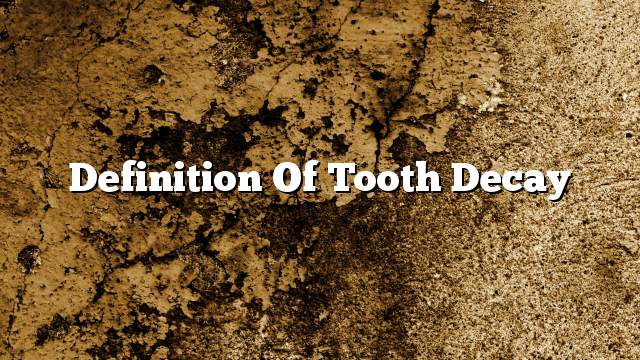tooth decay
Dental decay is the process of breaking the structure of the tooth, and this occurs when the accumulation of food residue on the teeth, and bacteria that live in the mouth digestion of these food residues and converted to acid, and this acid melts the outer layers of the tooth enamel, leaving behind the holes in the tooth called tooth decay Or tooth decay, tooth decay affects the inner layers of the tooth also affects the outer layers also.
Signs of tooth decay
When a person is exposed to tooth decay, he or she will most likely experience the following signs and symptoms:
- Dental pain: Pain may be persistent or severe.
- Sensitivity of teeth: A person feels pain when eating something cold, hot, or sweet taste.
- Brownish, gray, or black spots appear on the tooth.
- The smell of bad breath.
- Having a bad taste in the mouth.
- The presence of holes in the tooth.
- And pain threshold when biting or occlusion.
Stages of tooth decay
Tooth decay in stages is mentioned in the following:
- The plaque is the tooth or plaque : The sticky layer that covers the teeth, and made by the bacteria in the mouth by feeding on food residues and production of acid, and this layer is somewhat rough, and usually consists of the back teeth and next to the gums, and the plaque is a suitable place to hide bacteria, This layer and remove it harden and difficult to remove later.
- Attacking Blacks for Age: The acid in this layer produced by the bacteriapa attacks the hard and outer layer of the tooth. This results in small holes or holes in the tooth enamel. These holes are the first stage of tooth decay. When the tooth enamel is penetrated, decay moves to the next layer of tooth. Ivory, less hardened than tooth enamel, less resistant to acid effect.
- Continued damage: As the bacteria continue to produce acid, the effect of acid continues on the layers of teeth, and decay may continue to destroy the structure of the tooth until it reaches the core of the teeth, in this case a pain in the teeth, and this may continue to occur teeth abscess or inflammation.
Dental decay factors
There are some factors that help to get tooth decay, these factors include the following:
- Age: Teeth are more prone to tooth decay than others, because they contain many grooves and pits that help to collect the remnants of food.
- Types of food and drink: Some types of foods and drinks adhere to teeth, such as large amounts of milk, honey, cake, dried fruits, and therefore have a greater ability to cause tooth decay.
- Frequent snacks and drinks: Frequent eating feeds bacteria permanently, and drinking acidic or gaseous drinks leads to acidic acidity around the teeth all the time.
- Feeding children before sleeping: It is not recommended to give the child a bottle of milk, juice or various sugary drinks before sleeping; because the residues will stick to the teeth during the whole sleep; thus providing adequate food for decaying bacteria to carry out its activity.
- Do not clean the teeth enough: This causes the formation of the plaque quickly and start the first stages of decay.
- NEW YORK (Reuters Health) – Children and the elderly are the most vulnerable to decay, with older people suffering from gum decline and tooth decay, which makes them more likely to decay.
- Dry mouth: Dry mouth means a lack of saliva in the mouth. Saliva has an important role in protecting against decay. It ishes the teeth from the food residue and equates the acidity of the mouth caused by bacteria. Dry mouth results from chemotherapy, Or some types of medication, and other reasons.
- The body does not have enough fluoride: Fluoride has a major role in reversing the process of tooth damage, and re-mineralization of the tooth, and its importance is added to drinking water, and is usually added to toothpastes and mouthwashes.
- Weary fillings: Over time, dental fillings weaken and break, and this helps to easily collect deposits that are hard to remove.
Treatment of tooth decay
The treatment of tooth decay depends on the stage reached by decay. In the early stages of caries, the type of food, such as the amount of sugar consumed and the number of times of eating during the day, and the dentist may apply fluoride to the teeth, By strengthening the enamel of the teeth, in some cases the removal of decay and the placement of fillings in the tooth. In the advanced stages, decay may reach the pulp of the teeth, and then the treatment of the core of the tooth, and when the age reaches a stage where it is not reclaimed is taken.
Prevention of tooth decay
To protect against tooth decay, follow these tips:
- Clean teeth at least twice a day with fluoride toothpaste, preferably after each meal, especially before bedtime.
- Cleaning between the teeth using a medical dental floss, brush between the teeth, or any other method of cleaning between the teeth.
- Eat healthy and keep away from snacks and foods that stick to the teeth, and if taken, the teeth must be washed immediately afterwards.
- The use of a material to fill the cracks of the port, a substance placed on the surface of the back tooth and block the grooves to prevent the accumulation of food and tooth decay.
- Reduce the frequency of eating and drinking.
- Drink some tap water to contain fluoride, and it is important to note that the bottled water does not contain fluoride.
- Check your dentist regularly.
